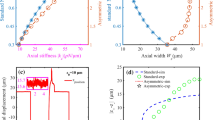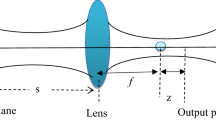Abstract
Recently, some authors have proposed to add an optical Kerr effect (OKE) while focusing the Gaussian beam (GB) enlightening an optical trap. These authors conclude that the introduction of a nonlinear lensing (NL) is benefit to the optical trapping capacity. The proposed modelling was based on the Gaussian approximation (GA) which assimilates the Kerr lensing effect to a pure lensing effect free from any aberration. In this paper, we evaluate the longitudinal and radial figures of merit of the optical trap based on NL using a diffraction integral taking into account the aberration associated with the OKE. The conclusion is that the GA modelling underestimates (overestimates) the improving of the longitudinal (radial) trapping ability of the optical trap. In summary, what is gained in the longitudinal efficiency of the nonlinear trap is lost in the radial force which decreases, thereby reducing the possibility to keep trapped the particle.









Similar content being viewed by others
References
A. Ashkin, Acceleration and trapping of particles by radiation pressure. Phys. Rev. Lett. 24, 156–159 (1970)
A. Ashkin, J.M. Dziedzic, Optical levitation by radiation pressure. Appl. Phys. Lett. 19, 282–285 (1971)
M.J. Padgett, J.E. Molloy, D. McGloin, Optical Tweezers, Methods and Applications (CRC Press, Taylor & Francis Group, 2010)
H. Jones, O.M. Marago, G. Volpe, Optical Tweezers: Principles and Applications (Cambridge University Press, 2015)
Y. Harada, T. Asakura, Radiation forces on a dielectric sphere in the Rayleigh scattering regime. Opt. Commun. 124, 529–541 (1996)
M.J. Lang, S.M. Block, Resource letter: LBOT-1: laser-based optical tweezers. Am. J. Phys. 71, 201–215 (2003)
M. Dienerowitz, M. Mazilu, K. Dholakia, J. Nanophotonics 2, 021875 (2008)
B.E.A. Saleh, M.C. Teich, Fundamentals of Photonics (Wiley-Interscience, 2007). (chap. 3)
Q.H. Quang, T.T. Doan, T.D. Quoc, V.D. Thanh, K.B. Xuan, L.L. Nguyen, T.N. Manh, Nonlinear microscope objective using thin layer of organic dye for optical tweezers. Eur. Phys. J. D. 74, 52 (2020)
A. Hasnaoui, M. Fromager, K. Aït-Ameur, About the validity of the parabolic approximation in Kerr lensing effect. Optik 193, 162986 (2019)
M. Sheik-Bahae, A.A. Said, T.H. Wei, D.J. Hagan, E.W. Van Strylland, Sensitive measurement of optical nonlinearities using a single beam. IEEE J. Quantum Electron. 26, 760–769 (1990)
A. Hasnaoui, K. Aït-Ameur, Simple modelling of nonlinear losses induced by Kerr lensing effect. Appl. Phys. B 127, 100 (2021)
M. Born, E. Wolf, Principles of Optics, 6th edn. (Pergamon, Oxford, 1980). (chap.8)
D.R. Hall, P.E. Jackson, The Physics and Technology of Laser Resonators (Institute of Physics Publishing, Bristol, 1989). (chap. 9)
J.A. Hermann, Self-focusing effects and applications using thin nonlinear media. Int. J. Nonlinear Phys. 1, 541–561 (1992)
S. Haddadi, K. Aït-Ameur, Improvement of optical trapping effect by structuring the illuminating laser beam. Optik 251, 168–439 (2022)
A. Hasnaoui, A. Bencheikh, K. Ait-Ameur, Tailored TEMp0 beams for large sizes 3-D laser prototyping. Opt. Las. Eng. 49, 248–251 (2011)
Funding
This research dis not receive any specific grant from funding agencies in the public, commercial, or not-for-profit sectors.
Author information
Authors and Affiliations
Contributions
The idea was proposed by Kamel Ait-Ameur. The results were done and analysed by Sofiane Haddadi and Kamel Ait-Ameur. The paper was written by all authors.
Corresponding author
Ethics declarations
Conflict of interest
The authors declare no conflict of interest.
Additional information
Publisher's Note
Springer Nature remains neutral with regard to jurisdictional claims in published maps and institutional affiliations.
Electronic supplementary material
Below is the link to the electronic supplementary material.
Appendices
Appendix
1. Calculation of the diffracted field \(E_{d} (r,z)\) by a series:
The first step for determining an analytical form for the integral given by Eq. (12) is to expand the phase term \(\exp [ - i\Delta \varphi (\rho )]\) where \(\Delta \varphi (\rho ) = \varphi_{0} \exp [ - 2\rho^{2} /W_{1}^{2} ]\)
The diffraction integral takes the following form:
With \(\beta = 2\pi r/(\lambda f_{L} )\) and \(\gamma = \frac{\pi }{\lambda }\left( {\frac{1}{z} - \frac{1}{{f_{L} }}} \right).\)
In the above equation we can recognise the following HANKEL transform
In the case where the function f takes the form \(f(\rho ) = \exp [ - a^{2} \rho^{2} /2]\), the Hankel transform \(F(\beta )\) is given by
Finally the diffracted field is written as follows:
where
where \(W_{F} = \frac{\lambda z}{{\pi W_{1} }}.\)
The summation in Eq. (A5) is truncated to a finite number of terms noted \(m_{\sup }\). Its value, for an accurate evaluation of \(E_{d} (r,z)\), increases with the value of \(\varphi_{0}\). For \(\varphi_{0} = 10rad\), only 25 terms in the sum are needed to be accurate within 1%.
2. The trap figure of merit \([Z_{L} ]_{GA}\) for Gaussian approximation
In this modelling, the Kerr lens is assimilated to a linear lens having a focal length \(f_{NL}\) given by Eq. (15).
3.1 Focusing without OKE
We start with the Gaussian intensity distribution given by Eq. (3) where \(W_{0} = \lambda f_{L} /(\pi W_{1} )\) is the beam-waist radius (best focus), and z = 0 the position of the best focus. The gradient of the on-axis intensity \(I(0,z)\) is written as follows:
where \(z_{0} = \pi W_{0}^{2} /\lambda\) is the Rayleigh distance of the focused Gaussian beam. It is easy to establish that the longitudinal gradient given above is minimum at position \(z_{\min } = z_{0} /\sqrt 3\). At this position, the gradient is minimum and its value is given by
The intensity at position \(z = z_{\min }\) is then given by
By applying Eq. (20), we obtain
3.2 Focusing with OKE
The previous calculation remains valid when \(\varphi_{0} > 0\) provided to replace \(W_{0}\) by \(W_{0}^{^{\prime}}\) given by
In presence of nonlinear lensing, Eq. (A10) is modified as follows:
Finally, we get the dimensionless figure of merit \([Z_{L} ]_{GA}\) obtained in the framework of the Gaussian Approximation
Rights and permissions
Springer Nature or its licensor (e.g. a society or other partner) holds exclusive rights to this article under a publishing agreement with the author(s) or other rightsholder(s); author self-archiving of the accepted manuscript version of this article is solely governed by the terms of such publishing agreement and applicable law.
About this article
Cite this article
Haddadi, S., Ait-Ameur, K. Optical tweezers based on nonlinear focusing. Appl. Phys. B 129, 38 (2023). https://doi.org/10.1007/s00340-023-07976-2
Received:
Accepted:
Published:
DOI: https://doi.org/10.1007/s00340-023-07976-2




